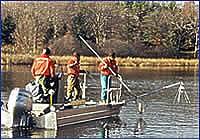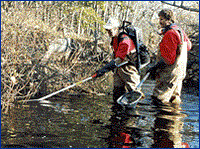EPA Region 1 Laboratory Electrofishing

Electrofishing is the technique and science of utilizing an electrical current to momentarily stun fish or force them to involuntarily swim towards an electrical field for collection. This method of collecting fish can be one of the best methods for non-lethal collections of resident fish species, allowing the scientist to temporarily collect organisms and retain them in an aerated holding tank until the right number, size, sex, or species have been collected.
Electrofishing is usually conducted using a boat equipped with an electrical generator, mainly for deep non-wadeable lakes and rivers, or using backpack mounted units for use in rivers and streams accessible by wading.
 Scientists use electro-fishing equipment for various purposes. Some surveys are done to determine contaminant levels in the tissues of various species highly desired for consumption by the fishing community or certain ethnic populations. Other surveys are conducted to determine the abundance of species along a river segment to determine the "biomass" that the water body is capable of supporting, and the relative abundances of various fish species. Other surveys may be initiated only to determine the type of fish species present, which often can be used as an indicator of water quality and the over all health of an aquatic system.
Scientists use electro-fishing equipment for various purposes. Some surveys are done to determine contaminant levels in the tissues of various species highly desired for consumption by the fishing community or certain ethnic populations. Other surveys are conducted to determine the abundance of species along a river segment to determine the "biomass" that the water body is capable of supporting, and the relative abundances of various fish species. Other surveys may be initiated only to determine the type of fish species present, which often can be used as an indicator of water quality and the over all health of an aquatic system.
Electrofishing is an invaluable tool for fisheries biologists and aquatic scientists, and if used properly, can provide a wealth of information and insight for managing some of our nations most precious resources.
